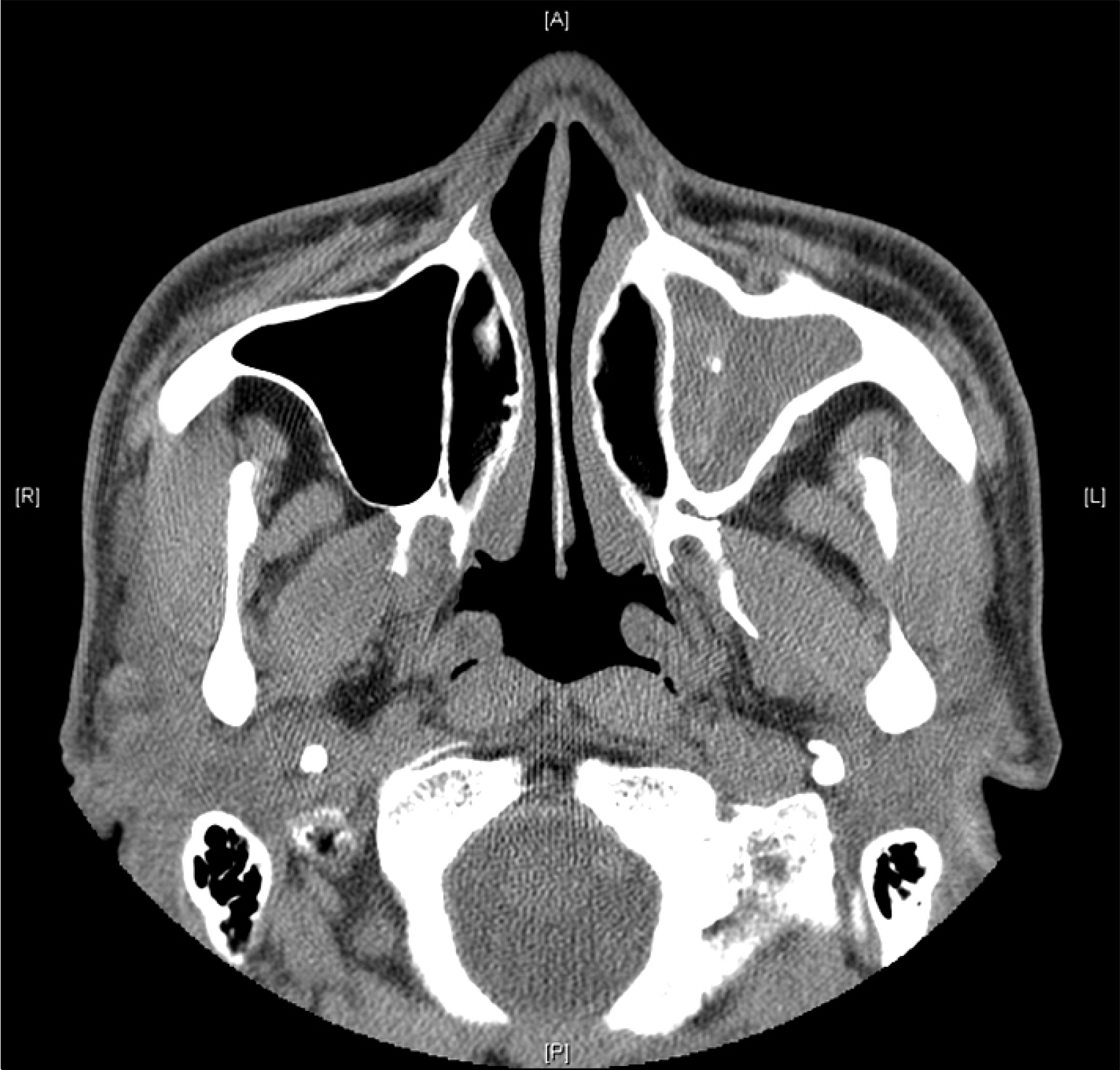J Korean Soc Transplant.
2011 Dec;25(4):245-248. 10.4285/jkstn.2011.25.4.245.
Paranasal Aspergillosis in Patients Prior to Liver Transplantation
- Affiliations
-
- 1Department of Surgery, Samsung Medical Center, Sungkyunkwan University School of Medicine, Seoul, Korea. jw.joh@samsung.com
- KMID: 1450972
- DOI: http://doi.org/10.4285/jkstn.2011.25.4.245
Abstract
- BACKGROUND
Aspergillosis infection is associated with high morbidity and mortality in liver transplant recipients. This study investigated the prognosis of liver transplant recipients with a pre-operative treatment for paranasal aspergillosis.
METHODS
We collected data from 979 cases of patients who underwent liver transplants at the Samsung Medical Center from May 1996 to Feburary 2010.
RESULTS
Eight patients were diagnosed with paranasal aspergillosis after functional endoscopic sinus surgery (FESS), before liver transplantation. In these 8 patients, 7 (87.5%) were male, with a mean age of 55 years. All patients had a hepatitis B virus infection, and 6 patients had hepatocellular carcinoma. The mean days from FESS to liver transplantation was 31 (range, 12~47 days) and anti-fungal agents were not used during these periods. All 8 patients were free from a recurrence of aspergillosis after liver transplantation.
CONCLUSIONS
Surgical treatment for paranasal aspergillosis in patients prior to liver transplantation does not induce aspergillosis infection after transplantation.
MeSH Terms
Figure
Reference
-
References
1). Wajszczuk CP, Dummer JS, Ho M, Van Thiel DH, Starzl TE, Iwatsuki S, et al. Fungal infections in liver transplant recipients. Transplantation. 1985; 40:347–53.
Article2). Kusne S, Dummer JS, Singh N, Makowka L, Esquivel C, Starzl TE, et al. Fungal infections after liver transplantation. Transplant Proc. 1988; 20:650–1.3). Castaldo P, Stratta RJ, Wood RP, Markin RS, Patil KD, Shaefer MS, et al. Clinical spectrum of fungal infections after orthotopic liver transplantation. Arch Surg. 1991; 126:149–56.
Article4). Kusne S, Torre-Cisneros J, Manez R, Irish W, Martin M, Fung J, et al. Factors associated with invasive lung aspergillosis and the significance of positive Aspergillus culture after liver transplantation. J Infect Dis. 1992; 166:1379–83.
Article5). Paterson DL, Singh N. Invasive aspergillosis in transplant recipients. Medicine (Baltimore). 1999; 78:123–38.
Article6). Schmidt A, Oberbauer R. Bacterial and fungal infections after kidney transplantation. Curr Opin Urol. 1999; 9:45–9.
Article7). Abbott KC, Hypolite I, Poropatich RK, Hshieh P, Cruess D, Hawkes CA, et al. Hospitalizations for fungal infections after renal transplantation in the United States. Transpl Infect Dis. 2001; 3:203–11.
Article8). Veroux M, Macarone M, Fiamingo P, Cappello D, Gagliano M, Di Mare M, et al. Caspofungin in the treatment of azole-refractory esophageal candidiasis in kidney transplant recipients. Transplant Proc. 2006; 38:1037–9.
Article9). Fisher NC, Singhal S, Miller SJ, Hastings JG, Mutimer DJ. Fungal infection and liposomal amphotericin B (AmBisome) therapy in liver transplantation: a 2 year review. J Antimicrob Chemother. 1999; 43:597–600.
Article10). Singh N. The changing face of invasive aspergillosis in liver transplant recipients. Liver Transpl. 2002; 8:1071–2.
Article11). Singh N, Avery RK, Munoz P, Pruett TL, Alexander B, Jacobs R, et al. Trends in risk profiles for and mortality associated with invasive aspergillosis among liver transplant recipients. Clin Infect DIs. 2003; 36:46–52.
Article12). Singh N, Paterson DL. Aspergillus infections in transplant recipients. Clin Microbiol Rev. 2005; 18:44–69.13). Singh N, Arnow PM, Bonham A, Dominguez E, Paterson DL, Pankey GA, et al. Invasive aspergillosis in liver transplant recipients in the 1990s. Transplantation. 1997; 64:716–20.
Article14). Ju MK, Joo DJ, Kim SJ, Chang HK, Kim MS, Kim SI, et al. Invasive pulmonary aspergillosis after solid organ transplantation: diagnosis and treatment based on 28 years of transplantation experience. Transplant Proc. 2009; 41:375–8.
Article15). Damm M, Quante G, Jungehuelsing M, Stennert E. Impact of functional endoscopic sinus surgery on symptoms and quality of life in chronic rhinosinusitis. Laryngoscope. 2002; 112:310–5.
Article16). Senior BA, Kennedy DW, Tanabodee J, Kroger H, Hassab M, Lanza D. Long-term results of functional endoscopic sinus surgery. Laryngoscope. 1998; 108:151–7.
Article17). Kuhn FA, Javer AR. Primary endoscopic management of the frontal sinus. Otolaryngol Clin North Am. 2001; 34:59–75.
Article18). Iro H, Mayr S, Wallisch C, Schick B, Wigand ME. Endoscopic sinus surgery: its subjective medium-term outcome in chronic rhinosinusitis. Rhinology. 2004; 42:200–6.
- Full Text Links
- Actions
-
Cited
- CITED
-
- Close
- Share
- Similar articles
-
- Aspergillosis in Liver Transplant Recipients: A Single Center Experience
- A Case of Pneumonectomy for Aspergillosis after Liver Transplantation: A case report
- Aspergillosis of the paranasal sinuses: diagnostic significance of the computed tomography
- A Case of Isolated Frontal Sinus Aspergillosis
- Chronic necrotizing pulmonary aspergillosis in a patient with liver cirrhosis



